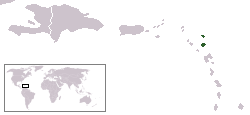Ekbletomys
Ekbletomys hypenemus là một loài gặm nhấm trong tông Oryzomyini thuộc họ chuột Cricetidae đã tuyệt chủng có nguồn gốc từ các đảo Antigua và Barbuda, Antilles nhỏ. Nó được mô tả là loài duy nhất của phân loài "Ekbletomys" của chi Oryzomys vào năm 1962. Nó hiện được gọi là "Ekbletomys hypenemus" khi không có tên chính thức có sẵn.
| Ekbletomys hypenemus | |
|---|---|
| Phân loại khoa học | |
| Giới (regnum) | Animalia |
| Ngành (phylum) | Chordata |
| Lớp (class) | Mammalia |
| Bộ (ordo) | Rodentia |
| Họ (familia) | Cricetidae |
| Phân họ (subfamilia) | Sigmodontinae |
| Tông (tribus) | Oryzomyini |
| Chi (genus) | Ekbletomys Ray, 1962 (unavailable name) |
| Loài (species) | E. hypenemus |
| Danh pháp hai phần | |
| Ekbletomys hypenemus (Ray, 1962) (unavailable name) | |
 | |
Đặc điểm
sửaĐặc điểm hình thái của nó chỉ ra rằng nó khác với Megalomys, bao gồm nhiều loại Antillean oryzomyines khác. Ekbletomys "được biết đến từ rất nhiều di chỉ xương phát hiện được từ Barbuda, bao gồm hơn một trăm xương chù và xương chày (xương của chân sau), bốn mảnh xương sọ (xương sọ). Các mấu vỏ (lưng) của các vòm cung (xương má) được định hướng vuông góc với trục chính của hộp sọ. Các răng hàm to. Vòm miệng ngắn, cho thấy "Ekbletomys" là một trong những loài chuột gạo Oryzomyini lớn nhất được biết đến.
Để định cư tại Barbuda và Antigua, "Ekbletomys" phải đến các hòn đảo thông qua việc vượt biển, có thể bằng phương tiện đi bè. Học giả Ray nghĩ rằng nó không thể xảy ra khi tổ tiên của con vật đến được hòn đảo này thông qua việc đi trên mặt nước (đảo nhảy) từ lục địa Nam Mỹ dọc theo Lesser Antilles đến Barbuda. Ngay cả khi mực nước biển giảm trong suốt thời Pleistocene, động vật vẫn phải vượt qua bảy rào chắn nước, một loạt các chuyến đi "không kém gì so với Sindbad". Thay vào đó, ông lập luận rằng con vật đã đến đảo trực tiếp trên một chiếc bè trôi dạt từ lục địa Nam Mỹ, có lẽ từ một trong những con sông lớn của lục địa này.
Tham khảo
sửa- Auffenberg, W. 1958. A small fossil herpetofauna from Barbuda, Leeward Islands, with the description of a new species of Hyla. Quarterly Journal of the Florida Academy of Sciences 21(3):248–254.
- Frost, D.R. 2009. Amphibian Species of the World: an online reference. Version 5.3 (ngày 12 tháng 2 năm 2009). Available at http://research.amnh.org/herpetology/amphibia/. American Museum of Natural History, New York, USA.
- Peterson, A.P. 2002. Zoonomen Nomenclatural data. Available at http://www.zoonomen.net. Truy cập ngày 11 tháng 9 năm 2009.
- Pregill, G.K., Steadman, D.W., Olson, S.L. and Grady, F.V. 1988. Late Holocene fossil vertebrates from Burma Quarry, Antigua, Lesser Antilles. Smithsonian Contributions to Paleobiology 463:1–27.
- Pregill, G.K., Steadman, D.W. and Watters, D.R. 1994. Late Quaternary vertebrate faunas of the Lesser Antilles: historical components of Caribbean biogeography. Bulletin of the Carnegie Museum of Natural History 30:1–51.
- Ray, C. E. 1962. The Oryzomyine Rodents of the Antillean Subregion. Doctor of Philosophy thesis, Harvard University, 211 pp.
- Simmons, N.B. 2005. Order Chiroptera. Pp. 312–529 in Wilson, D.E. and Reeder, D.M. (eds.). Mammal Species of the World: a taxonomic and geographic reference. 3rd ed. Baltimore: The Johns Hopkins University Press, 2 vols., 2142 pp. ISBN 978-0-8018-8221-0
- Steadman, D.W., Pregill, G.K. and Olson, S.L. 1984. Fossil vertebrates from Antigua, Lesser Antilles: Evidence for late Holocene human-caused extinctions in the West Indies. Proceedings of the National Academy of Sciences 81:4448–4451.
- Turvey, S.T. 2009. Holocene Extinctions. Oxford University Press US, 359 pp. ISBN 978-0-19-953509-5
- Uetz, P., et al. 2009. The Reptile Database. Available at http://www.reptile-database.org. Truy cập ngày 11 tháng 9 năm 2009.
- Watters, D.R., Reitz, E.J., Steadman, D.W. and Pregill, G.K. 1984. Vertebrates from archaeological sites on Barbuda, West Indies. Annals of Carnegie Museum 53(13):383–412.
- Wing, E.S., Hoffman, C.A., Jr. and Ray, C.E. 1968. Vertebrate remains from Indian sites on Antigua, West Indies. Caribbean Journal of Science 8(3–4):123–139.